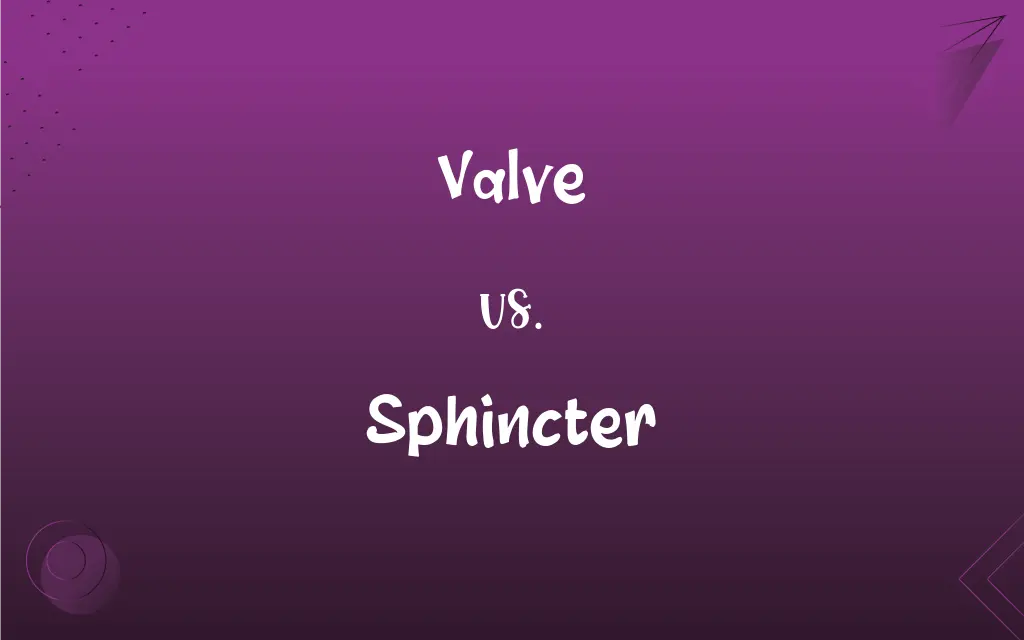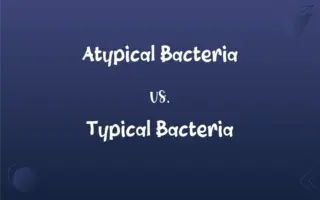Valve vs. Sphincter: What's the Difference?
Edited by Aimie Carlson || By Janet White || Published on January 29, 2024
A valve is a device regulating the flow of fluids by opening, closing, or partially obstructing passageways, whereas a sphincter is a ring-like muscle that controls the passage of substances in and out of a tube or cavity in the body.

Key Differences
A valve functions primarily in mechanical and hydraulic systems, designed to control the flow and pressure of liquids and gases. In contrast, a sphincter, found in biological organisms, is a specialized muscle forming a circular band, controlling the movement of materials within the body.
In terms of operation, valves work through mechanical movements, either manual or automated, to regulate flow. Sphincters, on the other hand, operate through muscle contractions, involuntarily or voluntarily, responding to bodily needs.
Valves are critical components in industrial and household systems like water pipes and engines, providing control over fluid dynamics. Sphincters play a key role in physiological processes such as digestion and excretion, maintaining the body's internal environment.
The design of a valve is based on mechanical principles, varying from simple taps to complex pressure-regulating systems. Sphincters, being biological structures, are designed by nature, with their efficiency and control intricately linked to health and bodily functions.
Maintenance and failure modes differ significantly; valves might require mechanical repair or replacement due to wear or damage. Sphincters can suffer from medical conditions like weakness or dysfunction, often addressed through medical treatments or lifestyle changes.
ADVERTISEMENT
Comparison Chart
Primary Function
Regulate flow of fluids in systems
Control passage in biological tubes or cavities
Operation Mechanism
Mechanical movements (manual/automated)
Muscle contractions (voluntary/involuntary)
Typical Usage
Industrial and household systems (pipes, engines)
Biological processes (digestion, excretion)
Design Principles
Based on mechanical engineering
Natural, biological design
Maintenance/Repair
Mechanical repair or replacement
Medical treatment or lifestyle changes
ADVERTISEMENT
Valve and Sphincter Definitions
Valve
A membranous fold in a hollow organ or tubular structure.
The heart's valve malfunction can lead to serious health issues.
Sphincter
A circular muscle used to control the passage of substances.
The anal sphincter regulates bowel movements.
Valve
A structure that opens and closes to permit the flow of a fluid in one direction only.
The check valve in the pump prevents backflow.
Sphincter
An anatomical structure functioning as a closing or restricting agent.
The pupil's sphincter controls the amount of light entering the eye.
Valve
A device for controlling the flow of a fluid.
The plumber adjusted the valve to stop the leak.
Sphincter
A muscle that surrounds and by contracting closes a bodily opening.
The esophageal sphincter prevents acid reflux.
Valve
A part of the shell of certain mollusks.
The scientist studied the valve structure of the mollusk.
Sphincter
A ring-like muscle which tightly closes the opening of a passage.
The sphincter muscle plays a vital role in digestion.
Valve
A device in a brass musical instrument for varying the pitch.
She expertly tuned the valves on her trumpet.
Sphincter
A muscle used to constrict a channel or opening in the body.
The urethral sphincter helps in controlling urination.
Valve
Any of various devices that regulate the flow of gases, liquids, or loose materials through piping or through apertures by opening, closing, or obstructing ports or passageways.
Sphincter
A ringlike muscle that normally maintains constriction of a body passage or orifice and that relaxes as required by normal physiological functioning.
Valve
The movable control element of such a device.
Sphincter
(muscle) A ringlike band of muscle that surrounds a bodily opening (such as the anus or the openings of the stomach), constricting and relaxing as required for normal physiological functioning.
The sphincter of the bladder
The iris sphincter in the eye
Sphincter
A muscle which surrounds, and by its contraction tends to close, a natural opening; as, the sphincter of the bladder.
Sphincter
Of, pertaining to, or designating, a sphincter; as, a sphincter muscle.
Sphincter
A ring of muscle that contracts to close an opening
FAQs
Where are sphincters located in the body?
In various locations, such as the digestive and urinary systems.
Are sphincters always under voluntary control?
No, some sphincters operate involuntarily.
How are valves maintained?
Through regular mechanical inspection and repair.
How are sphincter issues treated?
With medical treatments or lifestyle modifications.
Is the esophageal sphincter important for digestion?
Yes, it plays a crucial role in controlling food passage.
What is a valve?
A device that regulates the flow of fluids in a system.
Where are valves commonly found?
In mechanical and hydraulic systems, like pipes and engines.
Can valves be manually operated?
Yes, some valves are designed for manual operation.
What is a sphincter?
A ring-like muscle controlling passage in biological tubes or cavities.
What causes valve failure in systems?
Wear, damage, or mechanical failure.
Can valves regulate gas flow?
Yes, valves can control both liquid and gas flow.
Are there electronic valves?
Yes, some valves are electronically controlled.
Can valves be found in the human body?
Yes, such as heart valves.
What are common issues with sphincters?
Weakness or dysfunction, often due to health issues.
Do all animals have sphincters?
Most animals have sphincters for various bodily functions.
What's a safety valve?
A valve designed to release pressure to prevent system failure.
Is the iris a sphincter?
Yes, it functions as a sphincter in the eye.
Can sphincter muscles weaken with age?
Yes, they can weaken, leading to various issues.
What's the role of the anal sphincter?
It controls the expulsion of feces.
Are valves used in automobiles?
Yes, in systems like engines and fuel lines.
About Author
Written by
Janet WhiteJanet White has been an esteemed writer and blogger for Difference Wiki. Holding a Master's degree in Science and Medical Journalism from the prestigious Boston University, she has consistently demonstrated her expertise and passion for her field. When she's not immersed in her work, Janet relishes her time exercising, delving into a good book, and cherishing moments with friends and family.
Edited by
Aimie CarlsonAimie Carlson, holding a master's degree in English literature, is a fervent English language enthusiast. She lends her writing talents to Difference Wiki, a prominent website that specializes in comparisons, offering readers insightful analyses that both captivate and inform.









































































